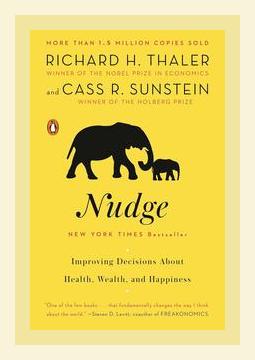Leadership and ManagementDecision Making
Introduction
“Nudge: Improving Decisions About Health, Wealth, and Happiness,” authored by Richard H. Thaler and Cass R. Sunstein in 2008, revolutionizes the way we understand decision making and human behavior. It explores the concept of “nudging,” a way to influence decisions while maintaining freedom of choice. The book is framed within the domain of libertarian paternalism, suggesting that subtle interventions can drastically improve individual and societal outcomes. This summary highlights the core principles, provides concrete examples from the book, and outlines specific actions one can take.
Core Principles of Nudging
-
Libertarian Paternalism
- Proposition: It is both possible and legitimate to steer people’s choices to improve their lives while still respecting their freedom to choose.
- Action: Implement default options in choices where one outcome is evidently better for individuals, such as automatically enrolling employees in retirement savings plans while giving them the option to opt-out.
-
Choice Architecture
- Proposition: The organization of the context in which people make decisions significantly impacts their choices.
- Example: Placing healthier foods at eye level in cafeterias increases the likelihood of choosing them over less healthy options.
- Action: Rearrange your kitchen so fruits and vegetables are more accessible than junk food to promote healthier eating habits.
Major Points and Examples from the Book
-
Status Quo Bias
- Insight: People tend to stick with pre-set options.
- Example: A study found that organ donation rates are significantly higher in countries where the default option is to be an organ donor compared to those where individuals must opt-in.
- Action: Opt into beneficial programs by setting helpful defaults for financial contributions, such as pre-scheduled transfers to a savings account.
-
Saving for Retirement
- Insight: Many people fail to save adequately for retirement due to inertia and procrastination.
- Example: Automatic Enrollment in 401(k) plans has significantly increased enrollment rates.
- Action: If you have a 401(k) or retirement savings plan at your workplace, opt into automatic escalation features that gradually increase your contribution rate.
-
Making Healthier Choices
- Insight: Small changes in how choices are presented can lead to healthier decisions.
- Example: A school cafeteria increased the sales of healthier foods simply by placing them at the start of the line where students are likely to pick them first.
- Action: When grocery shopping, start in the perimeter of the store where fresh produce and whole foods are usually located.
-
Environmental Goals
- Insight: Nudges can encourage pro-environmental behavior.
- Example: Prompting users to opt for electronic billing instead of paper can reduce paper waste and promote environmental sustainability.
- Action: Switch to paperless statements for your bank accounts and credit cards.
-
Simplifying Complex Choices
- Insight: Simplifying choices can lead to better decisions.
- Example: Drug plans with large, complex choices lead to poor decision making. Simplifying plan options helps consumers choose better plans.
- Action: When faced with complex decisions, break them down into smaller, simpler steps or categories to ease the decision-making process.
-
Social Proof and Peer Influence
- Insight: Individuals often look to the behavior of others when making decisions.
- Example: Energy companies that show customers how their energy usage compares to their neighbors can lead to reduced energy consumption.
- Action: Use social comparison to motivate positive behavior, such as joining a fitness group where members share their progress and goals.
-
Behavioral Insights for Policy Making
- Insight: Public policy can be structured to nudge citizens towards healthier, wealthier, and happier lives.
- Example: The successful implementation of Save More Tomorrow (SMarT) program, which helps employees commit to saving future salary increases.
- Action: Advocate for nudging techniques in local policy, such as promoting energy-efficient appliances through incentives or creating urban planning that encourages walking and biking.
Specific Actions to Take
-
Use Defaults Wisely
- Default actions significantly influence behavior. Default to the most beneficial option where possible.
- Action: Set up automatic bill payments to avoid late fees and maintain a good credit score.
-
Restructure Your Environment
- Small tweaks in your physical or digital environment can lead to better decisions.
- Action: Arrange your workspace to minimize distractions, such as keeping your phone out of reach during focused tasks.
-
Leverage Commitments
- Make commitments that are hard to break to encourage good behavior.
- Action: Join a pre-paid fitness program or schedule regular exercise sessions with friends to stay committed to regular physical activity.
-
Provide Clear and Immediate Feedback
- Immediate feedback from actions provides motivation and reinforces positive behavior.
- Action: Use a financial app to track expenses in real-time and set clear budgets to manage spending effectively.
-
Use Reminders and Prompts
- Simple reminders can help initiate positive behaviors.
- Action: Set recurring reminders for health-check appointments or routine maintenance activities to ensure they are not overlooked.
-
Simplify Your Choices
- Reduce the cognitive load by simplifying the array of choices.
- Action: When choosing insurance or investment plans, seek out tools or advisors that simplify the comparison of options.
-
Optimize Social Proof
- Surround yourself with positive influences and seek environments where desired behaviors are the norm.
- Action: Participate in community or online groups focused on goals similar to yours, such as financial independence or fitness.
Conclusion
Thaler and Sunstein’s “Nudge” demonstrates that small changes in the way choices are presented can lead to substantial improvements in decisions related to health, wealth, and happiness. By understanding the principles of libertarian paternalism and choice architecture, individuals and policymakers can design environments that naturally guide people toward better choices without restricting their freedom. By adopting these principles and leveraging the power of nudges, readers can make meaningful adjustments in their everyday lives, leading to overall better outcomes.
